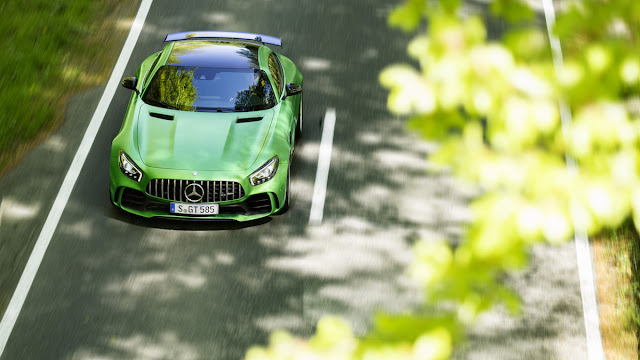After the SLS AMG, the Mercedes-AMG GT is the second sports car developed entirely in-house by Mercedes-AMG. The car is produced in two performance variations, the GT, with 340 kW (462 PS; 456 bhp), and the GT S with 375 kW (510 PS; 503 bhp). The GT has 600 N·m (443 lb·ft) of torque, and the GT S has 650 N·m (479 lb·ft) of torque.
The Mercedes-AMG GT uses a front mid-engine, rear-wheel-drive layout, with the engine inside the vehicle's wheelbase. The spaceframe chassis and body are made out of aluminium alloys, while the boot lid is steel and the engine bonnet magnesium. The suspensions are double wishbones front and rear, with forged aluminium wishbones and hub carriers.
The GT model is powered by a front-mid mounted M178 4-litre twin-turbo V8. Power is sent to the rear wheels through a transaxle 7-speed AMG SPEEDSHIFT dual-clutch transmission; the GT S model employs an electronically controlled mechanical limited-slip differential. It can accelerate from 0–60 mph in 3.0 seconds.
The Mercedes-AMG GT R is a new, high-performance variant of the GT was revealed at the Goodwood Festival of Speed in 2016. It features the same 4.0 L twin-turbocharged V8 engine (M178) used in the GT and GT S, but with power increased to 585 PS (430 kW; 577 bhp) and torque increased to 700 N·m (520 lb·ft). The GT R accelerates from 0 to 100 km/h (62 mph) in 3.6 seconds and has a claimed top speed of 320 km/h (200 mph).
The body colour on the concept is called AMG Green Hell Magno, and its name is a nod to the Nurburgring Nordschleife, where the car was developed.
The GT R has several cosmetic changes compared with the standard car, notably the vertical slats in the front grille, a fixed rear wing, new front air intakes and new front and rear diffusers. The styling of the GT R is more comparable to that of the AMG GT3 race car (photos below). The GT R will go on sale in November 2016, with deliveries expected in 2017. (wikipedia & autoblog.com)
The GT model is powered by a front-mid mounted M178 4-litre twin-turbo V8. Power is sent to the rear wheels through a transaxle 7-speed AMG SPEEDSHIFT dual-clutch transmission; the GT S model employs an electronically controlled mechanical limited-slip differential. It can accelerate from 0–60 mph in 3.0 seconds.
The Mercedes-AMG GT R is a new, high-performance variant of the GT was revealed at the Goodwood Festival of Speed in 2016. It features the same 4.0 L twin-turbocharged V8 engine (M178) used in the GT and GT S, but with power increased to 585 PS (430 kW; 577 bhp) and torque increased to 700 N·m (520 lb·ft). The GT R accelerates from 0 to 100 km/h (62 mph) in 3.6 seconds and has a claimed top speed of 320 km/h (200 mph).
The body colour on the concept is called AMG Green Hell Magno, and its name is a nod to the Nurburgring Nordschleife, where the car was developed.
The GT R has several cosmetic changes compared with the standard car, notably the vertical slats in the front grille, a fixed rear wing, new front air intakes and new front and rear diffusers. The styling of the GT R is more comparable to that of the AMG GT3 race car (photos below). The GT R will go on sale in November 2016, with deliveries expected in 2017. (wikipedia & autoblog.com)
2015 Mercedes-AMG GT3 Race Car
The racing variant of the Mercedes-AMG GT made its debut at the 2015 Geneva Motor Show. Unlike the road car on which it's based, Mercedes ditched the turbocharged V8 for its awesome 6.3-liter V8 on the GT3 race car. Mercedes conducted a serious overhaul of the car's aerodynamics, fitting a huge rear wing and an equally enormous front splitter. The front bumper is also home to a quartet of winglets, which add even more downforce to the front end. The rear of the car has been fitted with a none-too-subtle rear diffuser. Large ducts have been fitted to both sides of the rear bumper too. (autoblog.com)
(Photos from autoblog.com)


























































